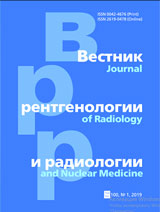Dear colleagues, friends,
On behalf of the Editorial Board and as the Editor-in-Chief, I invite you to collaborate with the oldest journal “Journal of Radiology and Nuclear Medicine”.
The journal celebrated its 100th anniversary in 2020.
“Journal of Radiology and Nuclear Medicine” is an official journal of the Russian Society of Radiology (RSR).
The entire international community of roentgenologists and radiologists, including basic and clinical academic researchers, medical specialists, as well as residents, postgraduates, and practitioners of related specialties, who write articles in Russian and English, are invited to submit contributions.
The journal is primarily published for practicing roentgenologists and radiologists, residents and postgraduates, and physicians of related specialties as a source of information about the latest methods in radiation diagnosis and radiation therapy, as well as for basic and clinical scientists to exchange research results.
The editorial board of the journal proposes to discuss the possibility of mutually beneficial and fruitful cooperation in the placement of advertising materials in the printed and electronic versions of the journal, as well as on its website.
Sincerely yours,
Professor Igor’ E. Tyurin,
Editor-in-Chief; Vice President of RSR; Chief of Radiology Chair, Russian Medical Academy of Continuing Professional Education; Ministry of Health of Russia; Chief Freelance Specialist in Radiation and Instrumental Diagnosis, Ministry of Health of Russia

Scientific and practical journal
The "Journal of Radiology and Nuclear Medicine" is the oldest scientific and practical journal (founded in 1920).
Higher Attestation Commissionis included in the list of leading peer-reviewed scientific journals and publications that should publish the main scientific results of dissertations for the degree of doctor and candidate of science.
Official journal of the Russian Society of Radiology (RSR). Presented in the Russian Science Citation Index (RSCI).
The journal is published 1 once in 2 months (February, April, June, August, October, December).
The Journal of Radiology and Nuclear Medicine publishes original articles covering the results of scientific research, descriptions of clinical cases, reviews of scientific literature on a wide range of issues of radiation diagnostics and radiation therapy, lectures, the results of congresses and congresses.
The Journal of Radiology and Nuclear Medicine was registered with the Federal Service for supervision of communications, information technologies and mass communications on November 13, 2017. (Certificate of registration ПИ № ФС 77-71544-print)
Announcements
| More Announcements... |













































